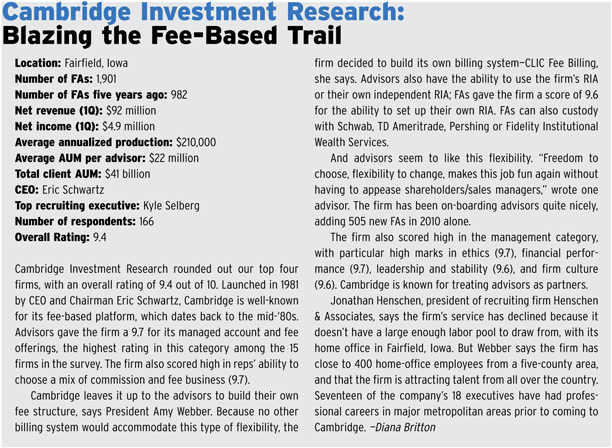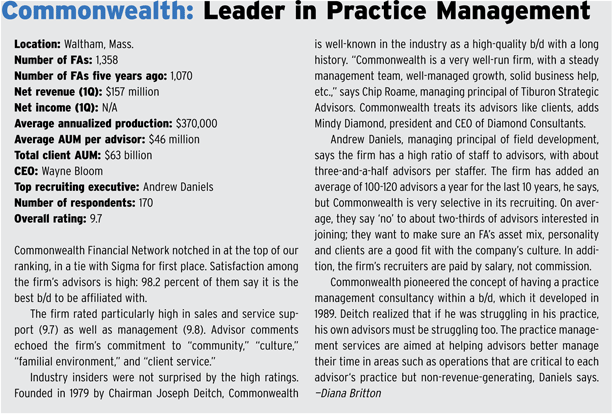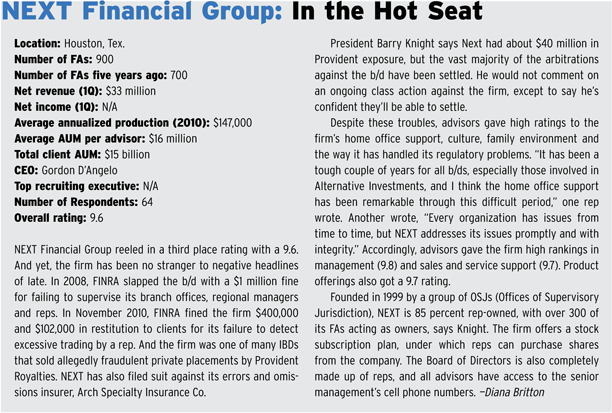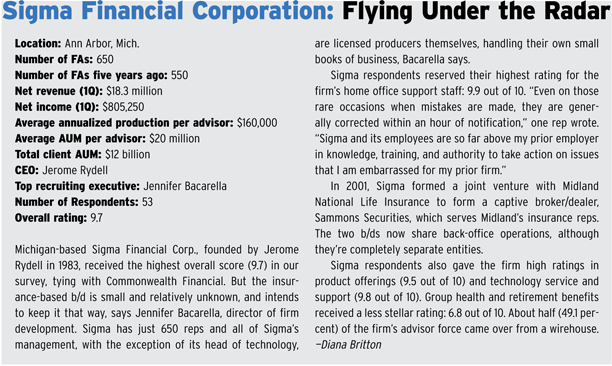Indie Winners: America’s Top Independent Brokerages
by Diana Britton and featured in Registered Rep
June, 2011:
Whatever happened to the indie exodus? The storied legions of breakaway brokers that were said to be fleeing Wall Street’s giant bureaucratic brokerages and heading to the promised land of independent firms where they could control their own destinies, select whatever products they wanted for their clients, and leave behind all of those knotty conflicts of interest? Yes, it is a phenomenon that has been widely debated in the financial services industry as well as in these pages.
The Merrills and Morgan Stanleys of the world say it was never an exodus, the migration is over, and it was only those advisors who couldn’t make it in the cutthroat wirehouse world who crossed over to the independent side of the business anyway — the ones who never got close to half a million in annual gross dealer concessions. Sallie Krawcheck recently reiterated this message at an Investment Company Institute meeting. All the hype about wirehouse firms losing advisors to independents is a myth, she said: Merrill lost just 36 of its FAs to independent firms last year, and then it recruited 25 FAs back from that side of the business. Indeed, Merrill lately seems to want to advertise the fact that it plans to recruit away from the independents.
Meanwhile, most recruiters — who win their bread by convincing advisors that today is the day to make a move, to switch firms, to change channels — have an understandably different vision of the world. It’s not just the low-end producers who moved or are moving, they say. A deterioration of trust in the big brands among investors and professionals alike is still driving advisors of all shapes and sizes to the independent firms, they say. And those who cross over almost never go back, they say.
So who’s right? The data (from Cerulli Associates, in this case) suggest that migration to the indie side of the business does continue, but it’s a trickle rather than a flood. Further, the largest advisors are, in fact, sticking with the wirehouse firms. Total headcount at the wirehouse firms is flat to declining: Cerulli estimates they will lose 1 percent of their market share of advisor headcount by 2014. And when you combine IBD, RIA and dually registered channels, total market share of client retail assets in this independent group is up to 34.8 percent. The wirehouse channel is just a hair ahead by comparison, with 38.1 percent of retail client assets. And yet, in the second quarter of 2009, only 12.5 percent of FAs who went to the IBDs from wirehouses managed $200 million or more in assets; 53 percent of advisors who moved from banks and regionals to the wirehouses had assets of more than $200 million, by contrast.
Our first Broker Report Card for Independent Broker/Dealers, a survey of 3,585 IBD advisors, backs the Cerulli data up. Switching into the channel from the wirehouse firms may be trailing off. According to the survey results, some 70.9 percent of respondents made the switch to independence in the last decade, with 14.4 percent of them moving over in 2009, 11.1 percent switching in 2010, and, only 1.7 percent so far this year.
That said, over a third of our IBD respondents previously worked for a wirehouse or full-service brokerage firm as an employee rep — about 36.6 percent. And there were a few major IBD firms where it was much, much higher, such as Wells Fargo Advisors Financial Network, where 85.8 percent came from a wirehouse; LPL Financial, with 76.8 percent; and Raymond James Financial Services, with 66.3 percent. These three firms have platforms and infrastructure that closely mimic those of the wirehouses, explains Mindy Diamond, president and CEO of Diamond Consultants.
More importantly perhaps, financial advisors at the independent broker/dealers are a pretty contented lot. For the most part, our advisor respondents gave strong ratings to their firms and said they plan to stay put. Overall, 84.7 percent of respondents said they’re “very likely” to still be with their current b/d in two years, with another 8.8 percent “somewhat likely” to stay. The percentage of advisors who said their own firm was the best to be affiliated with ranged from 60.2 percent to 98.2 percent.
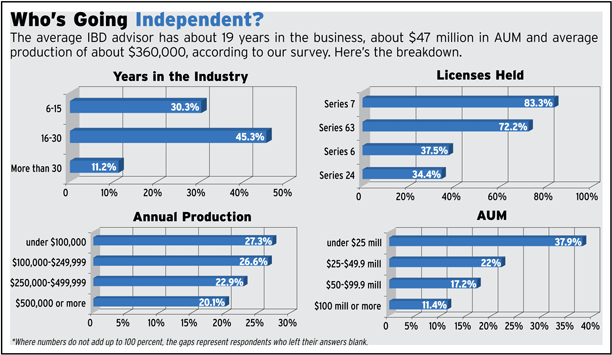
Breaking Away
For the most part, sources agree that the switch from the wirehouse model to independence will be an ongoing but slow trend. Cerulli Associates expects the wirehouse channel to lose 1 to 2 percent of its market share of assets per year, according to Scott Smith, senior analyst. In 2009, immediately following the financial crisis, there was a spike in movement as many advisors lost faith in the firms they worked for, says Jonathan Henschen, president of recruiting firm Henschen & Associates, which works mostly with IBDs. Last year, there was some additional residual switching related to the crisis. But those two years were something of an anomaly, Henschen thinks.
“2009 had both Merrill/BofA and Wells/Wachovia going on, as well as the MSSB [Morgan Stanley-Smith Barney] merger,” says Chip Roame, managing principal of Tiburon Strategic Advisors. “UBS was in the news every day. AIG was in trouble and losing reps. ING had its BDs for sale. It was a big year and that likely carried into early 2010. But the end of 2010 is perceived to have been bad for recruiting.”
Diamond says she is seeing more advisors who are considering independence, with 95 percent of her firm’s recruiting pipeline at least exploring the possibility. Danny Sarch of Leitner Sarch Consultants Ltd. in White Plains, N.Y., which recruits top talent for major brokerages, also says more advisors are asking about independence.
And even if it’s just a few reps moving every year, those numbers will add up. “Over time, a small trickle can create a pretty big lake,” says Philip Palaveev, president of Fusion Advisor Network, an RIA aggregator that recruits wirehouse advisors. “At the end of the day, Merrill can’t just turn their nose up at independence and say, ‘Those are our rejects.’”
Who’s Going Indy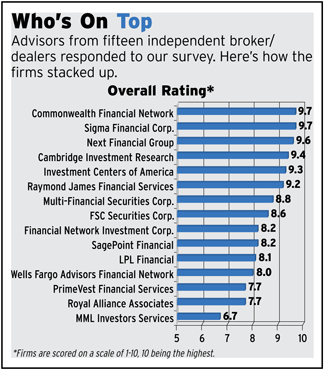
So who are these advisors that are going independent? Are they big or small? How long have they been in the industry? What licenses do they hold? Our survey gave us some insight into what the average IBD advisor looks like (see Table). Palaveev says there are two kinds of advisors leaving the wirehouses and going independent. “The first kind are advisors who are essentially encouraged to leave,” pushed out the door by the wirehouses if they don’t meet production quotas. “Those that don’t make the cut — they’re not necessarily bad advisors. On the contrary.” They’re just not good at selling, he says. “The criteria is revenue-driven.”
The second type of advisor going independent is someone with a well-established professional practice who wants to have more control over the business. He or she has a pretty sizeable practice and no problem generating revenue.
“We know for a fact that wirehouses have lost upwards of $10 billion in some cases,” Palaveev says.
Michael R. Durbin, president of Fidelity’s Institutional Wealth Services, says the number of breakaway brokers has been tapering off since the ’08-’09 spike, but the size of the teams is rising. In the first quarter of 2011, the average assets per Fidelity breakaway was $121 million, up 44 percent over the full-year 2010 average of $83 million. Larger firms are going independent because the capabilities of the firms that offer support have come a long way, he says.
These larger teams are the ones that firms on both sides of the debate are competing for, Palaveev says. The average IBD advisor has about $400,000 in revenues and $60 million in assets under management, he adds. They’re well-experienced, well-credentialed professionals in their 40s and 50s.
The Root of Happiness
For the most part, advisors surveyed were very satisfied with their respective firms. as mentioned above. They were also very pleased with the IBD model, with 68.3 percent saying it’s the best channel to work for. The second most popular channel was hybrid (b/d and RIA), with 28 percent.
This coincides with Fidelity’s 2011 Broker and Advisor Sentiment Index, a survey of 1,046 U.S. investment advisors from all channels, which found that the IBD and RIA channels had the highest levels of satisfaction, according to Sanjiv Mirchandani, president of National Financial, Fidelity’s clearing arm. Fifty-six percent said the independent model has become more attractive in today’s economic environment.
The overall satisfaction of IBD brokers could be an indication that the dust is settling on the recruitment front, says Aite Group analyst Alois Pirker. General movement between channels is stabilizing and calming down, and these advisors are not looking for change.
So what’s at the root of that happiness and stability? For one thing, assets and production are up from a year ago, a sign that the markets are improving. About 64 percent said their annual gross production increased from one year ago, while 61.8 percent indicated that assets under management were up over the same time period, including 34.4 percent who saw assets up 10 to 24 percent from a year ago. “When business is good, people don’t complain,” says Sarch.
Looking through advisor comments on why they plan to stick with their firm, the word ‘payout’ rarely came up, while the words ‘service,’ ‘support,’ ‘culture,’ ‘technology,’ ‘senior management,’ ‘home office staff,’ and ‘product offerings’ were common responses. Across all companies, advisors indicated they were most pleased with product offerings (8.9 out of 10), broker/dealer management (8.8 out of 10) and sales and service support (8.7 out of 10).
Meanwhile, among advisors at the top four-rated IBDs — Cambridge, Commonwealth Financial, Sigma Financial and NEXT Financial — those three aspects and three others were important: professional development opportunities, compliance support, and technology. Advisor feedback also stressed the importance of independence, flexibility and the ability to run their business as they see fit.
“It’s just a matter of how much control do you want to have?” says Palaveev. The guys at the wirehouses who want to control their business and practice, those are the guys who should be switching, he says.
In Registered Rep.’s survey, there wasn’t much of a gap between the lower-ranking firms and the higher-ranking firms, and this seems to be a reflection of what’s happening in the industry. While some of the firms in the survey have had their share of problems, advisors say they’re handling the issues with integrity, and that the firms are delivering on their promises.
“For the most part, I believe, most independents are doing their job pretty well,” Palaveev says. “Say what you will about independent broker/dealers, but they’re a little like gas stations. You can fill your car at any gas station. You may have a favorite one, but at the end of the day, any one will do the trick.”
The difference is, at a wirehouse, the name over your door tends to define who are. With the independents — “It’s your car. They just provide the fuel.”
